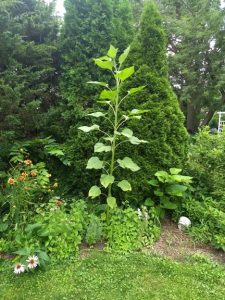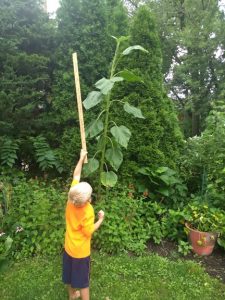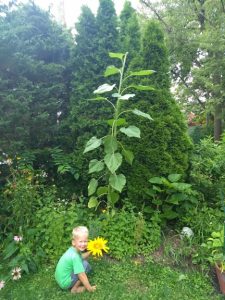Fun with Measuring: The Long and Short of It
For my kids, there is nothing more fun and exciting as playing with yardsticks, rulers and measuring tapes. These objects provide endless hours of fun in our household, namely, because my kids have discovered limitless uses for these tools of measurement. I am often astonished by my kids’ engagement and inventiveness when exploring in this manner – this is what makes learning math so cool!
In my previous blog, I discussed the creation of learning boxes and child-centered spaces in order to cultivate an inviting, investigative, and encouraging math environment for children of all ability levels. Objects are included in these boxes with the intent of inspiring young children’s curiosity, engaging participation in their own learning of skills and concepts, and encouraging discovery and innovation with the acquisition of new skills and concepts. Including rulers, tape measures, yard sticks and even yarn or string into your catalogue of math tools will boost a child’s investigative desire.
Measurement is one of the earliest mathematical concepts that children learn. Comparing the sizes of objects, determining which toy is the biggest, comparing which child is the tallest, and identifying that a plane is high up in the sky or a car is far away are all examples of how young learners begin to understand this concept. Building upon this understanding creates the foundation of logic, reasoning, comprehension and critical thinking skills necessary to set a child on a positive math journey. Exposure to these early experiences helps children begin to formulate interpretations of mathematical qualities in real-world problems.
Countless scholars and researchers have studied the significance of early math exposure, and the correlation between this and projected proficiency and success. Click here to listen to a top scholar discuss why early math matters! It is during the early years, that children acquire, practice, rehearse and build upon the skills that will eventually carry them through life.
One way I have found to engage young learners in the attainment of these skills is by allowing them to compare and measure. They often measure one another with yardsticks or tape measures, sometimes standing and other times lying on the ground. They have also traced one another with chalk on the driveway, and then measuring themselves that way. Often times they walk around our yard and measure flowers, plants and objects. This is a fun, entertaining and engaging activity, and they don’t even realize how much they are learning!
Recently, we realized that a sunflower seed we had planted was beginning to sprout and grow taller and taller. Each day my kids would observe the stalk getting bigger and bigger. First, it was taller than the grass, then the flowers, then each one of them!  They loved seeing the change and comparing the height, and I enjoyed watching their amazement.
They loved seeing the change and comparing the height, and I enjoyed watching their amazement.
Finally, one day they asked if it was taller than I was, and it floored them to realize that it was!  We decided to get out the yardstick and measure its final height, just as the sunflower’s face was beginning to bloom. We discussed how to measure an object and which end to start with. Then we had to do some adding, since the sunflower was taller than the yardstick (another discovery). We had a great time checking in on our gigantic plant each day, until we discovered that her head had gotten too heavy and had fallen to the ground. We did not stay upset too long, because soon they got the idea to get out the rulers and tape measures yet again to measure the width of that as well, which introduced a whole new math lesson on diameter and circumference!
We decided to get out the yardstick and measure its final height, just as the sunflower’s face was beginning to bloom. We discussed how to measure an object and which end to start with. Then we had to do some adding, since the sunflower was taller than the yardstick (another discovery). We had a great time checking in on our gigantic plant each day, until we discovered that her head had gotten too heavy and had fallen to the ground. We did not stay upset too long, because soon they got the idea to get out the rulers and tape measures yet again to measure the width of that as well, which introduced a whole new math lesson on diameter and circumference! 
Observing, measuring, comparing and analyzing the things around us helps young children make sense of their world. This can be an enjoyable way for young children to practice important math skills while guiding their own mastering of significant concepts. These experiences will then inspire, motivate and encourage them throughout their own life journey. I hope you enjoy fostering and cultivating your own special math adventures!
I like that the children are working outside.
It sounds like a good teaching tool
I love that it shows measuring outside. Great idea
I really like all the ideas and bringing it outside is a wonderful way to bring science with it.
I liked all of ir
I enjoyed reading about the children measuring the sunflower and discussing measurement by it being taller then the flowers and grass
I love the idea of having measuring tools out and accessible for my class. I teach 3 year olds, and I think they’d love to start exploring with rulers, etc. It’ll be fun to see what happens!
By using math outside is a great idea. That way you can incorrectly science in.
I appreciated the use of various measuring tools to explore their world. The fact that they were curious enough to draw their body outlines on the driveway in order to measure and compare to find who is taller. Great creativity and discovery. The work with the sunflower drew nature into the equation. The children learned the growing process of a plant and experienced recording the growth of that plant. In the end they had to face the reality of the plant becoming to heavy to bear its weight but they extended their curiosity to measure it from that angle and actually come face-to-face with the seeds of the sunflower. This was a measurement of time, space, weight and patience resulting in a harvest of tasty seeds.
i love the idea of taking the children outside and giving them tools to measure things that occur naturally in the real world. the children in my care are already engaged indoors. i will be taking them outside as soon as the weather permits it.
Great teaching tool!
I love the idea of letting the children explore outside and having fun but also learning! Any time you can bring the learning outside and make it fun, the better! I think kids retain more from activities that are fun for them to complete.
Measuring things outside is just as important as measuring inside.
I think this is a great learning experience for young learners to understand as they learn math concepts.
Children are usually enamored with shapes, sizes, and colors of objects-so it can be easier to incorporate the skill of measurement when they are learning about these things!
Hello,
I agree with your comments. Children are so curious about everything around them and like little sponges. I have heard about children learning the most of what will shape them later is what they learn between 1 and 5. I think they children should be introduced to measuring as long as it is fun and engaging like the sunflower example from the blog.
This little activity allows them to learn so much! I love that they not only got to watch the flower grow, but to measure it and realize how things can grow and change over time.
The sunflower sounds like a wonderful way to explore measurement.
What a great extension to bring the learning outside. You are not just teaching math but science as well.
I often forget about measuring and comparing and how much the children love to explore these topics. A great reminder to keep these ideas in the classroom consistantly
I loved that you used a yard stick. I feel yard sticks are a forgotten item now a day. What fun experiment you did with the sunflower seed.
I appreciated the various tools used to measure and the situations presented to the children. The most memorable for the children would probably be the sunflower. That was an awesome project that truly emphasized measurement.
I love this! Having the children measure the sunflower stalk is such a great idea and getting the children outdoors and in nature is even better. What a fun activity!
Measurement is very important because it gives kids a showing on which object is biggest or smallest.
I agree with using measurements because it helps children see which object is bigger or smaller.
I love the fact it is outside kids always love learning outside. what a fun idea!
it looks like a really fun way to get outside and learn at the same time.
I like the idea of measuring the sunflower. I bet the kids had so much fun. It would be fun to do that with each child and a string and see how much taller they are from the beginning, middle and end of the year.